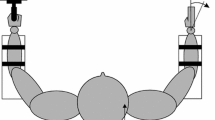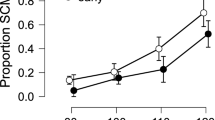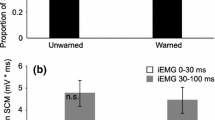Abstract
In reaction time (RT) tasks where fast ballistic movements are required, the requisite action is generally preplanned to enable the quickest responses. When a loud acoustic stimulus (e.g., >120 dB) that elicits a startle response is presented during the preplanning phase, the movement is triggered involuntarily and at a sufficiently short enough latency to discount normal cortical initiation processes. It has been suggested that the startle triggers the action by providing sufficient additional activation to surpass the initiation threshold. It is unclear, however, whether similar RT shortening due to startle would occur in the absence of an excitatory motor output. Thus, in the current study, participants performed a flexion force offset (i.e., inhibition) task within a simple RT paradigm. A startling acoustic stimulus (SAS) was presented in place of the usual “go” signal on several trials. Results from startle trials showed that the inhibitory command could be elicited substantially earlier by an SAS (latency of ~78 ms) compared to control trials (120 ms). This suggests active inhibition is preprogrammed and can be triggered early by startle in similar way to traditional “excitatory” tasks. Additionally, early startle-related EMG activity superimposed with the triggered offset suggests that the nature of the inhibitory command used in the current experiment involves the active suppression of ongoing motor output.



Similar content being viewed by others
References
Brown P, Rothwell JC, Thompson PD, Britton TC, Day BL, Marsden CD (1991) New observations on the normal auditory startle reflex in man. Brain 114:1891–1902
Buccolieri A, Abbruzzese G, Rothwell JC (2004) Relaxation from a voluntary contraction is preceded by increased excitability of motor cortical inhibitory circuits. J Physiol (Lond) 558:685–695
Carlsen AN, Chua R, Inglis JT, Sanderson DJ, Franks IM (2003) Startle response is dishabituated during a reaction time task. Exp Brain Res 152:510–518
Carlsen AN, Chua R, Inglis JT, Sanderson DJ, Franks IM (2004a) Can prepared responses be stored subcortically? Exp Brain Res 159:301–309
Carlsen AN, Chua R, Inglis JT, Sanderson DJ, Franks IM (2004b) Prepared movements are elicited early by startle. J Motor Behav 36:253–264
Carlsen AN, Dakin CJ, Chua R, Franks IM (2007) Startle produces early response latencies that are distinct from stimulus intensity effects. Exp Brain Res 176:199–205
Carlsen AN, Chua R, Summers JJ, Inglis JT, Sanderson DJ, Franks IM (2009) Precues enable multiple response preprogramming: Evidence from startle. Psychophysiol 46:241–251
Carlsen AN, Maslovat D, Franks IM (in press) Preparation for voluntary movement in healthy and clinical populations: evidence from startle. Clin Neurophysiol. doi:10.1016/j.clinph.2011.04.028
Castellote JM, Kumru H, Queralt A, Valls-Solé J (2007) A startle speeds up the execution of externally guided saccades. Exp Brain Res 177:129–136
Cui RQ, MacKinnon CD (2009) The effect of temporal accuracy constraints on movement-related potentials. Exp Brain Res 194:477–488
Cui RQ, Huter D, Lang W, Deecke L (1999) Neuroimage of voluntary movement: topography of the Bereitschaftspotential, a 64-channel DC current source density study. Neuroimage 9:124–134
Deecke L, Grozinger B, Kornhuber HH (1976) Voluntary finger movement in man: cerebral potentials and theory. Biol Cybern 23:99–119
Di Lazzaro V, Restuccia D, Oliviero A, Profice P, Ferrara L, Insola A, Mazzone P, Tonali P, Rothwell JC (1998) Magnetic transcranial stimulation at intensities below active motor threshold activates intracortical inhibitory circuits. Exp Brain Res 119:265–268
Hebb DO (1949) The organization of behavior; a neuropsychological theory. Wiley, New York
Kornhuber HH, Deecke L (1965) Changes in the brain potential in voluntary movements and passive movements in man: readiness potential and reafferent potentials. Pflugers Arch Gesamte Physiol Menschen Tiere 284:1–17
Kujirai T, Caramia MD, Rothwell JC, Day BL, Thompson PD, Ferbert A, Wroe S, Asselman P, Marsden CD (1993) Corticocortical inhibition in human motor cortex. J Physiol (Lond) 471:501–519
Kumru H, Valls-Solé J (2006) Excitability of the pathways mediating the startle reaction before execution of a voluntary movement. Exp Brain Res 169:427–432
Landis C, Hunt WA, Strauss H (1939) The startle pattern. Farrar & Rinehart, New York
MacKinnon CD, Bissig D, Chiusano J, Miller E, Rudnick L, Jager C, Zhang Y, Mille ML, Rogers MW (2007) Preparation of anticipatory postural adjustments prior to stepping. J Neurophysiol 97:4368–4379
Reynolds RF, Day BL (2007) Fast visuomotor processing made faster by sound. J Physiol (Lond) 583:1107–1115
Rothwell JC (2006) The startle reflex, voluntary movement, and the reticulospinal tract. In: Cruccu G, Hallett M (eds) Brainstem function and dysfunction. Elsevier, Amsterdam
Rothwell JC, Higuchi K, Obeso JA (1998) The offset cortical potential: an electrical correlate of movement inhibition in man. Mov Disord 13:330–335
Rothwell JC, MacKinnon CD, Valls-Solé J (2002) Role of brainstem-spinal projections in voluntary movement. Mov Disord 17:S27–S29
Rothwell JC, Day BL, Thompson PD, Kujirai T (2009) Short latency intracortical inhibition: one of the most popular tools in human motor neurophysiology. J Physiol (Lond) 587:11–12
Siegmund GP, Inglis JT, Sanderson DJ (2001) Startle response of human neck muscles sculpted by readiness to perform ballistic head movements. J Physiol (Lond) 535:289–300
Siegmund GP, Blouin JS, Inglis JT (2008) Does startle explain the exaggerated first response to a transient perturbation. Exerc Sport Sci Rev 36:76–82
Terada K, Ikeda A, Nagamine T, Shibasaki H (1995) Movement-related cortical potentials associated with voluntary muscle-relaxation. Electroencephalogr Clin Neurophysiol 95:335–345
Valls-Solé J, Solé A, Valldeoriola F, Muñoz E, Gonzalez LE, Tolosa ES (1995) Reaction time and acoustic startle in normal human subjects. Neurosci Lett 195:97–100
Valls-Solé J, Rothwell JC, Goulart F, Cossu G, Muñoz E (1999) Patterned ballistic movements triggered by a startle in healthy humans. J Physiol (Lond) 516:931–938
Valls-Solé J, Kumru H, Kofler M (2008) Interaction between startle and voluntary reactions in humans. Exp Brain Res 187:497–507
Wickens JR, Hyland B, Anson G (1994) Cortical cell assemblies—a possible mechanism for motor programs. J Motor Behav 26:66–82
Yeomans JS, Frankland PW (1996) The acoustic startle reflex: neurons and connections. Brain Res Rev 21:301–314
Acknowledgments
This research was supported by grants from the Natural Sciences and Engineering Research Council of Canada (NSERC) awarded to IM Franks and to QJ Almeida.
Author information
Authors and Affiliations
Corresponding author
Rights and permissions
About this article
Cite this article
Carlsen, A.N., Almeida, Q.J. & Franks, I.M. Startle decreases reaction time to active inhibition. Exp Brain Res 217, 7–14 (2012). https://doi.org/10.1007/s00221-011-2964-9
Received:
Accepted:
Published:
Issue Date:
DOI: https://doi.org/10.1007/s00221-011-2964-9




